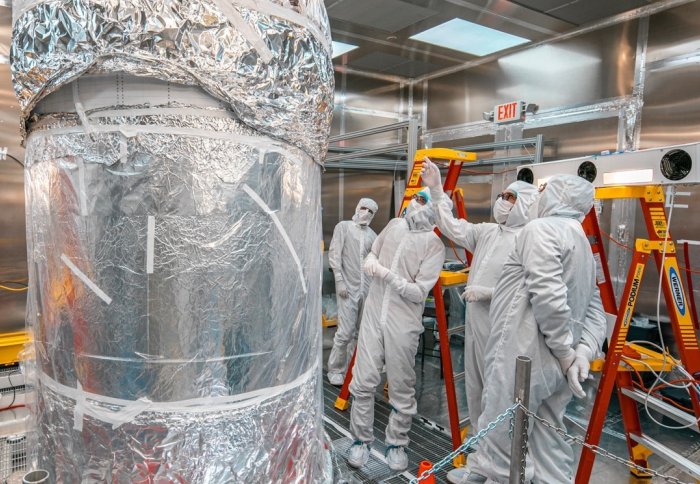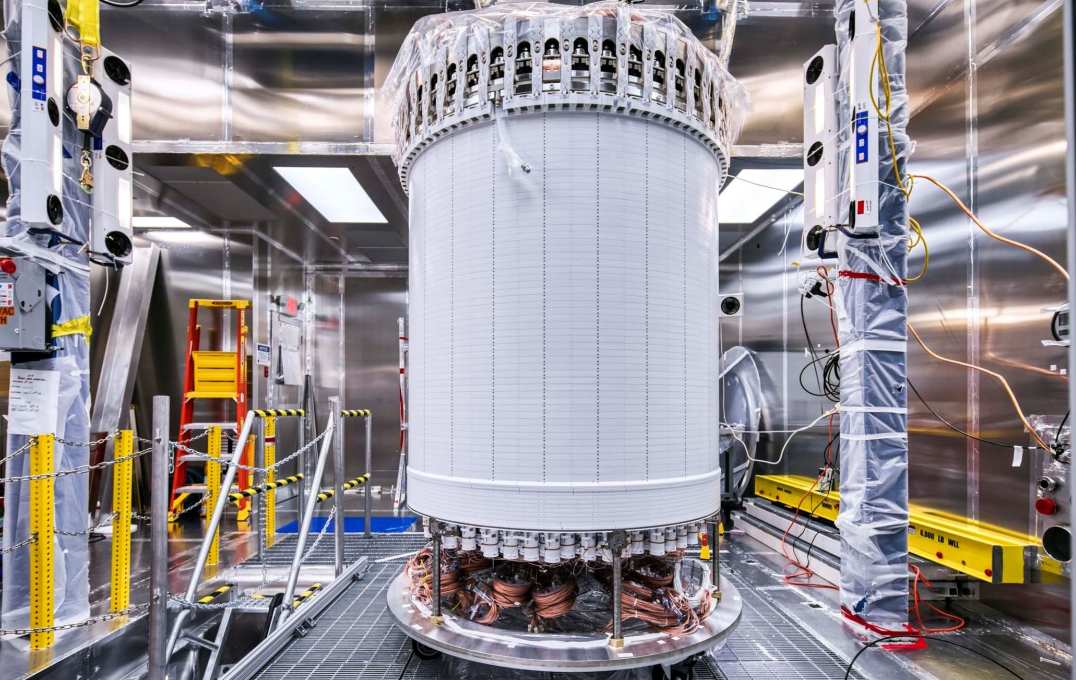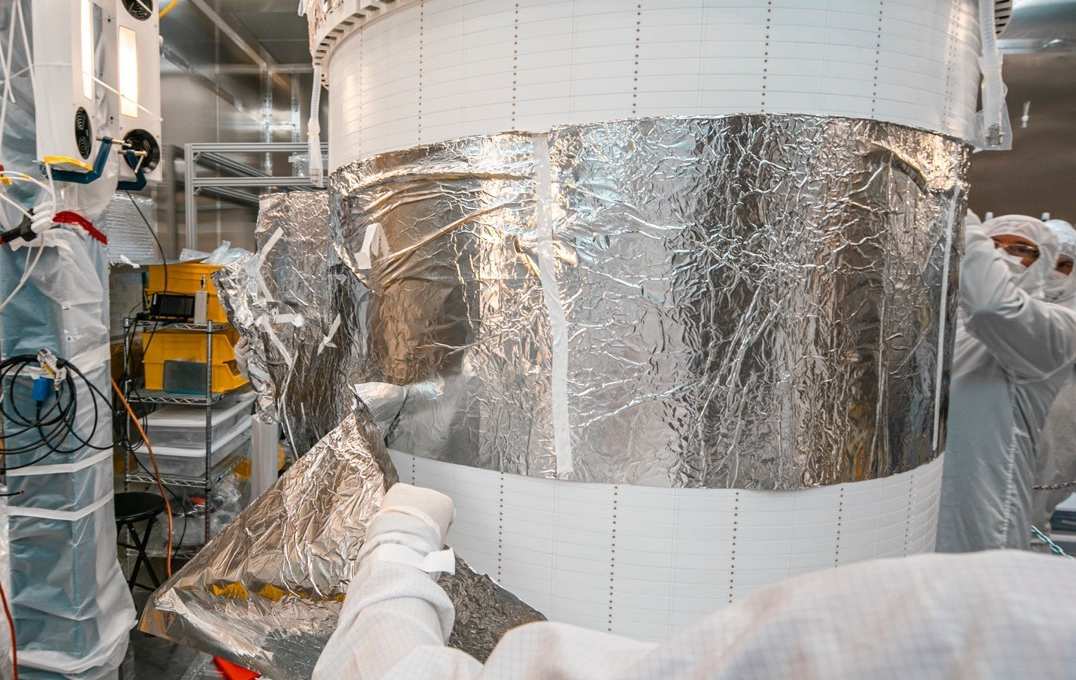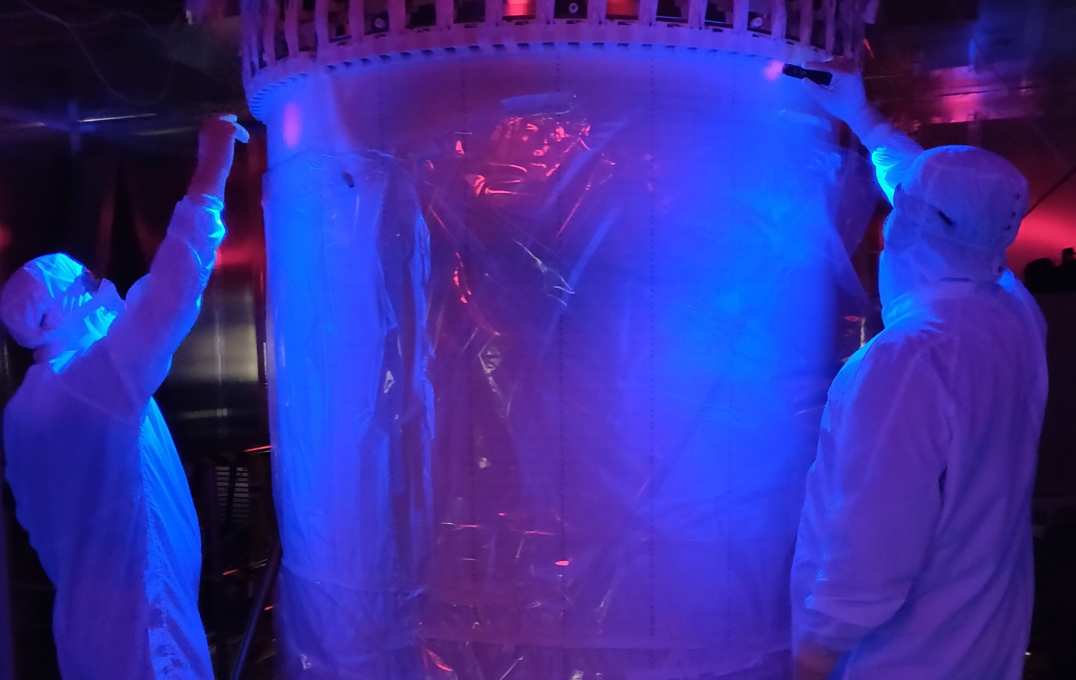
Researchers examine the foil-wrapped LUX-ZEPLIN xenon detector. Credit: Matt Kapust

The key component of the LUX-ZEPLIN experiment is ready to be sealed and lowered nearly 1.5 km underground, where it will search for dark matter.
Dark matter is a mysterious form of matter thought to make up around 85% of the mass of the universe. However, because it is predicted to interact only very weakly with ordinary matter, it has so far not been detected.
LZ is a bit like a space experiment, just headed the opposite direction. Professor Henrique Araújo
LUX-ZEPLIN (LZ) will be the most sensitive dark matter experiment ever built. On 26 July, researchers finished assembling its centrepiece, the liquid xenon Time Projection Chamber (TPC), at the Sanford Underground Research Facility in South Dakota, USA.
“This xenon detector will be at the heart of the LZ dark matter experiment,” said Professor Henrique Araújo, from the Department of Physics at Imperial College London, who leads the LZ collaboration efforts in the UK and co-led the development of the TPC with Professor Tom Shutt from SLAC National Accelerator Laboratory.
13,500 hours of effort
To assemble the TPC, 250 members from 37 institutions from across the globe came together to ensure the mechanical, optical, electrical, radiological and cleanliness requirements of the project were met.
Manufacture of the tens of thousands of components that make up the TPC started in 2015, and assembly of the instrument began in December 2018. The integration stage involved 13,500 hours of effort – a significant fraction of which was devoted to maintaining the required ultra-clean conditions at the surface-level assembly lab.
Next, it will be inserted into its cryostat vessel – a chamber that maintains cold temperatures – and lowered nearly 1.5km underground into a disused goldmine, ready to hopefully detect dark matter. Operations are planned to start in mid-2020.
“We have some things in common with a space program,” said Professor Araújo. “Before you launch, you do all of your work on the ground for years, perfecting the engineering so your instrument will work no matter what. LZ is a bit like a space experiment, just headed the opposite direction. We cannot expose it to underground air – that would compromise its performance. Once you deploy it underground, that's it. It has to work.”
Detecting WIMPs
Once underground, the detector will be cooled to -100oC and filled with ten tonnes of liquid xenon. Because xenon is a heavy element, there is a higher chance of xenon atoms interacting with hypothetical dark matter particles called WIMPs – weakly interacting massive particles.
Researchers believe that if a WIMP interacts with a xenon atom, it will produce two flashes of light. One appears promptly, when the particle collides with a xenon atom, which recoils through the liquid. The second is generated by electrons shaken off by the collision, which are guided to the top of the detector and accelerated through a layer of gaseous xenon above the liquid.
Although these flashes would be imperceptible to the human eye, the detector is lined with hundreds of photomultiplier tubes. These ultrasensitive sensors can amplify a signal from even a single photon of light.
Decades of development
The TPC design employed by LZ has been perfected over decades of experimentation with similar detectors that allow researchers to determine where an interaction happens, and whether it is likely due to a background interaction in the instrument or a true dark matter signal. Amongst these were the ZEPLIN-III experiment at the Boulby Mine in North Yorkshire, led by Imperial, and the US-led LUX experiment – which gave rise to LZ.
The TPC is a complex system and it's a major achievement to have it fully assembled. Professor Tom Shutt SLAC National Accelerator Laboratory
Being buried deep underground protects the experiment from too many background interactions from processes readily detected at the surface that could obscure a dark matter signal, such as the cosmic rays that shower the Earth from outer space.
Professor Shutt said: “The TPC is a complex system and it's a major achievement to have it fully assembled. It takes us one important step closer to being able to look for dark matter.
“It is also gratifying because it involved assembling a large number of subsystems designed and built by groups across the US and the UK over a number of years. So, it’s a coming together of sorts for the collaboration.”
Major support for LZ comes from the US Department of Energy Office of Science, the South Dakota Science and Technology Authority, the UK’s Science & Technology Facilities Council and by collaborating members in South Korea and Portugal.
Supporters

Article text (excluding photos or graphics) © Imperial College London.
Photos and graphics subject to third party copyright used with permission or © Imperial College London.
Reporter
Hayley Dunning
Communications Division

Contact details
Email: press.office@imperial.ac.uk
Show all stories by this author








Leave a comment
Your comment may be published, displaying your name as you provide it, unless you request otherwise. Your contact details will never be published.